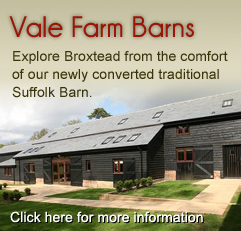History
The barns at Vale Farm represented an unusually complete mid-Victorian farm complex and are therefore of considerable historic interest.
Vancouver barn started life as a five-bay weather-boarded barn with slate roof flanked by grain bins and feed sheds. Brand Barn was a timber-framed stable and hay loft while Sewell Barn consisted of loose boxes with “mucking-out hatches” to the north. Below is a list of the 10 horses housed at The Vale taken from the Annual Stocktaking valuation, October 1932,in addition to 13 horses at The Brook Farm, 16 at Ramsholt marsh, and 11 at Broxtead making a total of 50 working horses used on the estate.
Running parallel to these barns are a series of stables that once housed driving horses and sheds for cattle. The car park is flanked by an early 19th century cart lodge and first-floor granary of five bays.
Vale Farm House was originally the main farm house for the Sink Farm estate and was occupied by John Brand upon his succession in 1813 (for more information on John Brand, read “Sutton People” a book by Greville Bickerton available from the Estate Office). During his occupation he planted a “pleasure garden” to the rear of the farm house – an “ornamental miniature park with pathways and a water feature”. Vale Farm House has a good ghost story attached to it – read page 97 and 98 in Sutton People.
For more information on John Brand, read “Sutton People” a book by Greville Bickerton available from the Estate Office or visit www.suttonpeople.com.
Woodcock Hill
Two streams serve the area of the present estate. In pre-history, they were rivers providing communication and defence for the local populace. The British Neolithic, immigrants from the continent, were the first known people to populate the peninsula. Later still (4,600BC to 2,700 BC) nomadic hunter gatherer late-glacial people traversed the area in their search for food, mainly deer. Evidence of their early presence in found in crop marks and flint articles.
Following them were the Bronze Age folk who left crop marks and barrows. Woodcock Hill is the site of such a barrow where once man could sail from the sea as far as this hill. (All that is left of this river now is one of the two streams called the Black ditch.) The locals would have used it as a look-out as part of their defences. Standing at the top of the hill today evokes very clearly the concept of a settlement well defended and with ready access to the sea as the only practicable route.
Earth works, Shottisham
The second “river”, Mill Stream, flows from Frogs Hole, north of Broxtead House down the Shottisham Creek where it meets the River Deben. On a rise to the north of the Church there are at least six single or double ring-ditches which have been observed as crop-marks, which indicate an early settlement.
WWII airfields
 What is now the Aerodrome field and plantation was a decoy airfield in World War II. The two buildings that remain on the edge of the site are all that is visibly left of the Aerodrome. One concrete foundation has pockets for holding down bolts which may have been for the generator which supplied the power for the “runway” lights. These were turned on only on notification of the imminent passage of enemy planes.
What is now the Aerodrome field and plantation was a decoy airfield in World War II. The two buildings that remain on the edge of the site are all that is visibly left of the Aerodrome. One concrete foundation has pockets for holding down bolts which may have been for the generator which supplied the power for the “runway” lights. These were turned on only on notification of the imminent passage of enemy planes.
In German flight plans, the airfield is referred to as Hollesley Aerodrome. The operational airbase nearby, RAF Woodbridge (now Rock Barracks) was not built until 1942. These flight plans are dated June 1941 so it is a reasonable assumption that the nearby “decoy” airfield here on the Broxtead Estate was a success!
Broxtead House and Farm
The house was built in 1799 by John Vancouver, with white Flemish bond brick with a slate roof. The hipped roof was renewed in 1920 with its current roof. John Vancouver was the brother of the famous navigator and explorer, George Vancouver who gave his name to that city in Canada. He lived in Broxtead House until the estate was sold in 1832 to the Thellusson Trustees whose various and numerous tenants farmed the lands here.
On 16th June 1914, the entire estate was bought, at auction, by R H & R Paul to augment their malting business and to proved sporting occasions for their customers, many of whom were wealthy North German maltsters.
Forty six days later World War One began with the German invasion of Belgium.
R H & R Paul still farm and manage the estate today under the leadership of Mr “AJ” Paul.






